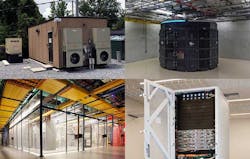What’s hot in edge computing? What are the use cases gaining traction? That’s today’s topic in our Data Center Executive Roundtable, as our panel of experienced data center executives weighs in the evolution of edge infrastructure and business models. Our panelists include Andrew Schaap from Aligned, Phillip Marangella of EdgeConneX, Vertiv’s John Hewitt, Kevin Facinelli from Nortek, Iron Mountain’s Michael DeVito, Katie O’Hara of Stream Data Centers and Infrastructure Masons, and Eric Jensen from Data Aire.
The conversation is moderated by Rich Miller, the founder and editor of Data Center Frontier. Here’s today’s discussion:
Data Center Frontier: Edge computing continues to be a hot topic. How is this sector evolving, and what use cases and applications are gaining the most traction with customers?
JOHN HEWITT, Vertiv
John Hewitt: The edge is central to everything happening now and in the future in our industry. The need for fast, powerful computing close to the consumer is only going to increase, and organizations that can deliver that computing faster and more reliably are going to race ahead. The nature of 5G makes edge computing critical to telecom providers and is raising foundational questions among providers – including the most foundational question of all: AC or DC? (Or, more accurately, both?)
Retail is increasingly reliant on edge computing to support in-store applications, distribution centers and logistics, and online retail. The pandemic drove massive increases in the use of edge-reliant telehealth applications as doctors and health care providers managed patient health during a year when they couldn’t see their patients. Those behaviors will not just snap back to pre-pandemic routine. Already, hospitals and health networks were becoming more distributed, mirroring the IT industry by moving services out of the hospital and closer to patients. The federal government is deep into a modernization effort that is driving applications to the edge. Educational institutions – from K-12 through higher ed – are relying on computing in classrooms more than ever, and this requires edge computing. The applications are endless, and the list is only going to grow moving forward.
PHILLIP MARANGELLA, EdgeConneX
Phillip Marangella: Edge computing means so many different things to different businesses. For some, edge computing is a far edge deployment of small-footprint, purpose-built facilities that have very discrete needs. For others, it can mean IoT deployments in almost any industry – agriculture, automotive, aerospace, the list is literally endless. And for still others it can mean an intermediate processing point for connecting to the cloud.
Customers want to use the edge to get faster, more secure access to the cloud. They want to distribute content intelligently. They need interconnections to networks and proximity to an ecosystem of service providers that can help them succeed with cloud migrations and digital transformation projects.
The edge today is literally where you need it, when you need it, and at the scale you need for virtually any business. Our customers drive us to be more creative, responsive, and agile, and we empower our customers to be able to do whatever they need to do to push the boundaries of what’s possible for their businesses.
MICHAEL DeVITO, Iron Mountain
Michael DeVito: The explosion in IoT is driving huge volumes of transactional activity closer to the edge of the network. This means that locating compute nodes within low latency reach of these devices is both a critical necessity and a big challenge for enterprises and clouds.
To compete in the digital economy, businesses need transactional agility in connecting multiple platforms, suppliers and services from the edge, to the core and to the cloud. This process supports use cases that reside around low latency, data residency, user experience, and applies to a multitude of industries including gaming, high frequency trading, travel, finance and healthcare.
Iron Mountain is seeing increased demand for edge markets, especially for key strategic assets that we have within the broader Iron Mountain real estate portfolio. We believe edge is not only here to stay, but will be a major driver of global growth and connectivity.
ANDREW SCHAAP, Aligned
Andrew Schaap: I think trends such as continued 5G adoption, AI/ML, and autonomous vehicles will continue to gain traction in the coming years, and lend themselves well to edge deployments. Along with the sector, I think that the definition of edge computing itself is also somewhat evolving.
The edge shouldn’t be defined by the physical size of a data center, but by the application and its latency to a specific end point. The nature of what the application actually is dictates the physical size and location of the data center, as well as its proximity to the device or person using it. So, if you’re streaming content, you want to be as close as possible to a cable headend or cell phone C-RAN. If you’re doing mailer messaging or machine learning computation, that edge might be a multi- megawatt, adaptive data center in a metropolitan area.
KEVIN FACINELLI, Nortek Data Center Cooling
Kevin Facinelli: We see the edge computing sector evolving as network capabilities evolve, such as 5G. High speed network connections still need to connect back to accommodating facilities, such as a hyperscalers or large colocation. Another issue that is driving edge computing, is data privacy. The whole idea of social media is to globalize communication, but some countries have restrictions.
So large cloud computing companies are building data centers within regions where the data can be monitored and restricted by the respective country. As data privacy issues evolve in different countries globally, localized data solutions, versus global solutions, will continue to increase, which we think will help grow business as well.
ERIC JENSEN, Data Aire
Eric Jensen: The edge moves and changes shape. Maybe always will. High tech manufacturing and healthcare are two places the edge is evolving. High tech manufacturing and warehousing is adopting more autonomous robotic operation needing to be updated and to learn in situ.
As healthcare becomes more digitally-oriented, whether because of the connected devices in a modern healthcare setting or the adoption of telehealth, firmware and applications need to be reliably robust, and secure in the healthcare provider’s hands.
KATIE O’HARA, Stream Data Centers and iMasons.
Katie O’Hara: With edge computing continuing to gain momentum, we’ve seen clients continue to split their load between carrier hotels and suburban locations by placing the larger compute footprint in more resilient facilities with better economies of scale. We’ve also seen interest in leveraging our parent company’s multi-million square foot office and industrial portfolio to quickly deploy smaller edge footprints across the U.S.
Keep pace with the fact-moving world of data centers and cloud computing by following us on Twitter and Facebook, connecting with DCF on LinkedIn, and signing up for our weekly newspaper using the form below:
About the Author




